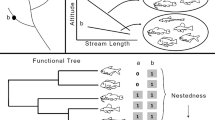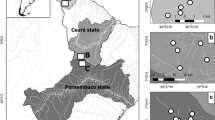Abstract
The importance of channel complexity in maintaining biological integrity and ecosystem functioning has been addressed by several researchers. In spite of this, High-Andean streams are being channelized without regard to the effect that channelization might have on stream communities. To attempt to determine these effects, the present study evaluated how caddisfly assemblages respond to channelization in a High-Andean stream. A trait-based approach was used to compare trait-based responses, and the degree of functional homogenization caused by channelization. A total of seven traits are described: (i) ‘Food,’ (ii) ‘Feeding habits,’ (iii) ‘Maximum body size,’ (iv) ‘Adaptation to flow constrains,’ (v) ‘Body flexibility,’ (vi) ‘Case-material,’ and (vii) ‘Case-shape.’ Both the functional structure of the assemblages and the channel complexity of the channelized site were characterized and compared to those of two undisturbed sites. The results suggest that certain genera become dominant as a result of the environmental changes caused by partial channelization. Specifically, assemblages underwent significant specialization in ‘Food,’ ‘Feeding habits,’ and ‘Case-shape,’ and this was linked to the homogenization in mesohabitat type and in hydraulic variability. The trends evident in the trait-based responses may serve as a basis for proposing and assessing strategies to restore the hydromorphological integrity of High-Andean streams.





Similar content being viewed by others
References
Angrisano, E. B. & J. V. Sganga, 2009. Trichoptera. In Dominguez, E. & H. R. Fernández (eds), Macroinvertebrados bentónicos sudamericanos: sistemática y ecología (255–308). Fundación Miguel Lillo, Tucumán: 255–308.
Armitage, P. D. & I. Pardo, 1995. Impact assessment of regulation at the reach level using macroinvertebrate information from Mesohabitats: Regulated Rivers. Research & Management 10: 147–158.
Beisel, J. N., P. Usseglio-Polatera, S. Thomas & J. C. Moreteau, 1998. Stream community structure in relation to spatial variation: the influence of mesohabitat characteristics. Hydrobiologia 389: 73–88.
Beisel, J. N., P. Usseglio-Polatera & J. C. Moreteau, 2000. The spatial heterogeneity of a river bottom: a key factor determining macroinvertebrate communities. Hydrobiologia 422–423: 163–171.
Bonada, N., C. Zamora-Muñoz, M. Rieradevall & N. Prat, 2004. Ecological profiles of caddisfly larvae in Mediterranean streams: implications for bioassessment methods. Environmental Pollution 132: 509–521.
Boyero, L., 2003. The quantification of local substrate heterogeneity in streams and its significance for macroinvertebrate assemblage. Hydrobiologia 499: 161–168.
Chevenet, F., S. Dolédec & D. Chessel, 1994. A fuzzy coding approach for the analysis of long-term ecological data. Freshwater Biology 31: 295–309.
Demars, B. O. L., J. L. Kemp, N. Friberg, P. Usseglio-Polatera & D. M. Harper, 2012. Linking biotopes to invertebrates in rivers: biological traits, taxonomic composition and diversity. Ecological Indicators 23: 301–311.
Dohet, A., D. Dolisy, L. Hoffmann & M. Dufrêne, 2002. Identification of bioindicator species among Ephemeroptera, Plecoptera and Trichoptera in a survey of streams belonging to the rhithral classification in the Grand Duchy of Luxembourg. Verhandlungen der Internationalen Vereinigung fur Theoretische und Angewandte Limnologie 28: 381–386.
Dolédec, S. & B. Statzner, 2008. Invertebrate traits for the biomonitoring of large European rivers: an assessment of specific types of human impact. Freshwater Biology 53: 617–634.
Dolédec, S., B. Statzner & M. Bournaud, 1999. Species traits for future biomonitoring across ecoregions: patterns along a human-impacted river. Freshwater Biology 42: 737–758.
Edwards, C. J., B. L. Griswold, R. A. Tubb, E. C. Weber & L. C. Woods, 1984. Mitigating effects of artificial riffles and pools on the fauna of a channelized warmwater stream. North American Journal of Fisheries Management 4: 194–203.
Elosegi, A. & S. Sabater, 2013. Effects of hydromorphological impacts on river ecosystem functioning: a review and suggestions for assessing ecological impacts. Hydrobiologia 712: 129–143.
Elosegi, A., J. Diez & M. Mutz, 2010. Effects of the hydromorphological integrity on biodiversity and functioning of river ecosystems. Hydrobiologia 657: 199–215.
Gotsner, W., M. Alp, J. A. Schleiss & C. T. Robinson, 2013. The hydromorphological index of diversity: a tool for describing habitat heterogeneity in river engineering projects. Hydrobiologia 712: 43–60.
Growns, I. O. & J. A. Davis, 1994. Longitudinal changes in near-bed flows and macroinvertebrate communities in a Western Australian stream. Journal of the North American Benthological Society 13: 417–438.
Gutiérrez, J. D., 2006. Caracterización del metabolismo y de la oferta de recursos de Materia orgánica para la fauna de macroinvertebrados bentónicos en una quebrada de montaña de orden menor. Doctoral Thesis, Universidad Nacional de Colombia.
Heino, J., P. Louhi & T. Moutka, 2004. Identifying the scales of variability in stream macroinvertebrate abundance, functional composition and assemblage structure. Freshwater Biology 49: 1230–1239.
Holzenthal, R. W., J. C. Morse & K. M. Kjer, 2011. Animal biodiversity: an outline of higher-level classification and survey of taxonomic richness. Zootaxa 3148: 209–211.
Hutchinson, G. E., 1957. The multivariate niche. Cold Spring Harbor Symposia on Quantitative Biology XXII: 415–427.
Lamouroux, N., S. Dolédec & S. Gayraud, 2004. Biological traits of stream macroinvertebrate communities: effects of microhabitat, reach, and basin filters. Journal of the North American Benthological Society 23: 449–466.
Lancaster, J. & B. J. Downes, 2010. Ecohydraulics needs to embrace ecology and sound science, and to avoid mathematical artifacts. River Research and Applications 26: 921–929.
Li, H. & J. F. Reynolds, 1995. On definition and quantification of heterogeneity. Oikos 73: 280–284.
Li, J., A. Herlihy, W. Gerth, P. Kaufmann, S. Gregory, S. Urquhart, & D.P. Larsen, 2001. Variability in stream macroinvertebrates at multiple spatial scales.Freshwater Biology 46: 87–97.
Mackay, R. J. & G. B. Wiggins, 1979. Ecological diversity in Trichoptera. Annual Review of Entomology 24: 185–208.
Malm, T., K. A. Johanson & N. Wahlberg, 2013. The evolutionary history of Trichoptera (Insecta): a case of successful adaptation to life in freshwater. Systematic Entomology 38: 459–473.
McGill, B. J., B. J. Enquist, E. Weiher & M. Westoby, 2006. Rebuilding community ecology from functional traits. Trends in Ecology and Evolution 21: 178–185.
Menezes, S., D. J. Baird & A. M. Soares, 2010. Beyond taxonomy: a review of macroinvertebrate trait-based community descriptors as tools for freshwater biomonitoring. Journal of Applied Ecology 47: 711–719.
Mérigoux, S. & S. Dolédec, 2004. Hydraulic requirements of stream communities: a case study on invertebrates. Freshwater Biology 49: 600–613.
Mondy, C. P. & P. Usseglio-Polatera, 2014. Using fuzzy-coded traits to elucidate the non-random role of anthropogenic stress in the functional homogenization of invertebrate assemblages. Freshwater Biology 59: 584–600.
Moutka, T. & P. Laasonen, 2002. Ecosystem recovery in restored headwater streams: the role of enhanced litter retention. Journal of Applied Ecology 39: 145–156.
Negishi, J. N. & J. S. Richardson, 2003. Responses of organic matter and macroinvertebrates to placements of Boulder clusters in a small stream of southwestern British, Columbia, Canada. Canadian Journal of Fisheries and Aquatic Sciences 60: 247–258.
Negishi, J. N., M. Inoue & M. Nunokawa, 2002. Effects of channelisation on stream habitat in relation to a spate and flow refugia for macroinvertebrates in northern Japan. Freshwater Biology 47: 515–517.
Posada-García, J. A. & G. Roldán-Pérez, 2003. Clave ilustrada y diversidad de las larvas de Trichoptera en el nor-occidente de Colombia. Caldasia 25: 169–192.
Quinn, J. M., R. B. Williamson, R. K. Smith & M. L. Vickers, 1992. Effects of riparian grazing and channelisation on streams in Southland, New Zealand. 2. Benthic invertebrates. New Zealand Journal of Marine and Freshwater Research 26: 259–273.
R Core Team 2014. R: A language and environment for statistical computing. R Foundation for Statistical Computing, Vienna, Austria. http://www.R-project.org
Resh, V. H., 1992. Recent trends in the use of Trichoptera in water quality monitoring. Proceedings of the seventh International Symposium on Trichoptera 1992: 285–291.
Scarsbrook, M. R. & C. R. Townsend, 1993. Stream community structure in relation to spatial and temporal variation: a habitat templet study of two contrasting New Zealand streams. Freshwater Biology 29: 395–410.
Schmera, D. & T. Eros, 2004. Effect of riverbed morphology, stream order and season on the structural and functional attributes of caddisfly assemblages (Insecta: Trichoptera). International Journal of Limnology 40: 193–200.
Southwood, T. R. E., 1977. Habitat, the templet for ecological strategies? Journal of Animal Ecology 46: 337–365.
Statzner, B. & L. A. Bêche, 2010. Can biological invertebrate traits resolve effects of multiple stressors on running water ecosystems? Freshwater Biology 55: 80–119.
Statzner, B., J. A. Gore & V. H. Resh, 1988. Hydraulic stream ecology: observed patterns and potential applications. Journal of the North American Benthological Society 7: 307–360.
Tachet, H., P. Usseglio-Polatera & C. Roux, 1994. Theoretical habitat templets, species traits, and species richness: Trichoptera in the Upper Rhône River and its floodplain. Freshwater Biology 31: 397–416.
Thorp, J. H., M. C. Thoms & M. D. Delong, 2006. The riverine ecosystem synthesis: biocomplexity in river networks across space and time. River Research and Applications 22: 123–147.
Tomanova, S. & P. Usseglio-Polatera, 2007. Patterns of Benthic community traits in neotropical streams: relationship to mesoscale spatial variability. Fundamental and Applied Limnology 170: 243–255.
Townsend, C. R. & A. G. Hildrew, 1994. Species traits in relation to a habitat templet for river systems. Freshwater Biology 31: 265–275.
Townsend, C. R., M. R. Scarsbrook & S. Dolédec, 1997. Quantifying disturbance in streams: alternative measures of disturbance in relation to macroinvertebrate species traits and species richness. Journal of the North American Benthological Society 16: 531–544.
Vázquez-Ramos, J., G. Guevara-Cardona & G. Reinoso-Flórez, 2014. Environmental factors associated with habitat preferences by caddisfly larvae in tropical dry forest watersheds (Tolima, Colombia). Revista de Biología Tropical 62: 21–40.
Wallace, J. B. & J. R. Webster, 1996. The role of macroinvertebrates in stream ecosystem function. Annual Review of Entomology 41: 115–139.
Wiggins, G., 2004. Caddisflies: The Underwater Architects. University of Toronto Press, Toronto.
Wiggins, G. B. & W. Wichard, 1989. Phylogeny of pupation in Trichoptera, with proposals on the origin and higher classification of the order. Journal of the North American Benthological Society 8: 260–276.
Wilcock, D. N. & C. I. Essery, 1991. Environmental impacts of channelization on the River Main, County Antrim, Northern Ireland. Journal of Environmental Management 32: 127–143.
Acknowledgments
The author would like to thank J. Ch. Donato-Rondon and two anonymous reviewers for their helpful comments on the manuscript, and Neil Hunt for correcting the English text. Special thanks to L. Alonso-Moreno, M. González Oviedo, E. C. González Trujillo, J. P. Álvarez-Silva, G. Giraldo, O. Combita, and R. Ospina for their help in the field and the laboratory, and to Nevardo and Carlos Bello (‘Acueducto de Bogotá – E.A.B.’) who provided access to ‘La Vieja’ stream.
Author information
Authors and Affiliations
Corresponding author
Additional information
Handling editor: Checo Colón-Gaud
Electronic supplementary material
Below is the link to the electronic supplementary material.
Rights and permissions
About this article
Cite this article
González-Trujillo, J.D. Trait-based responses of caddisfly assemblages to the partial channelization of a High-Andean stream. Hydrobiologia 766, 381–392 (2016). https://doi.org/10.1007/s10750-015-2474-z
Received:
Revised:
Accepted:
Published:
Issue Date:
DOI: https://doi.org/10.1007/s10750-015-2474-z




